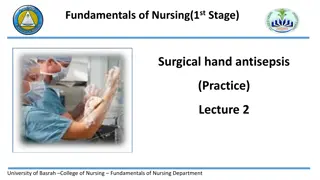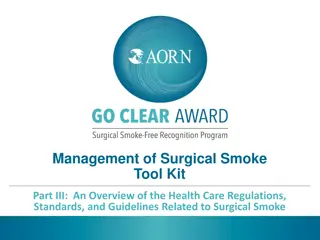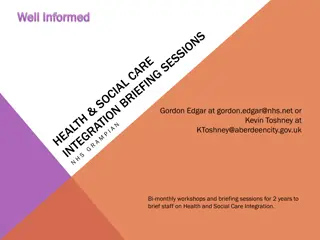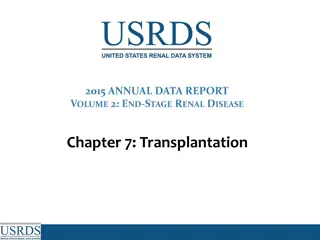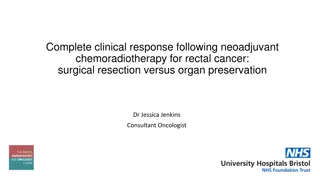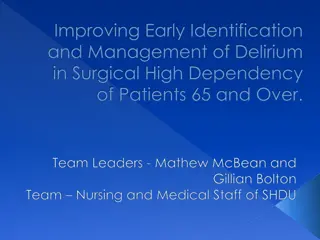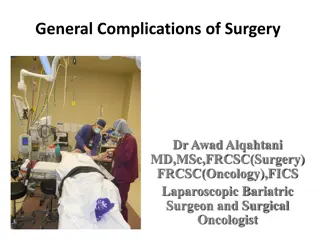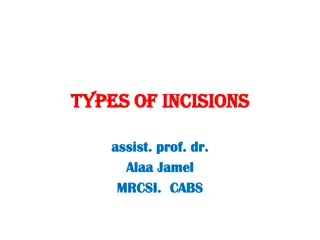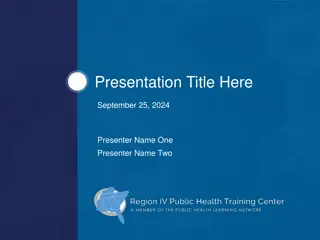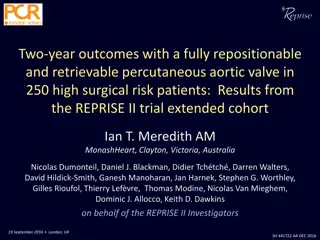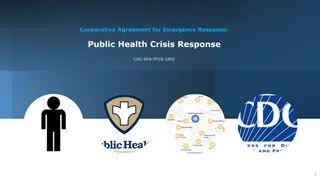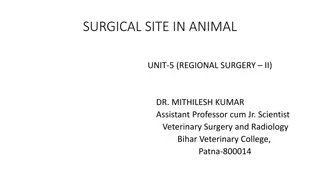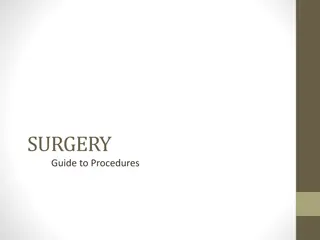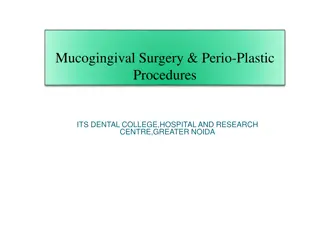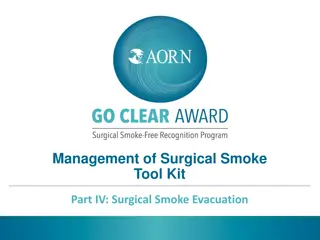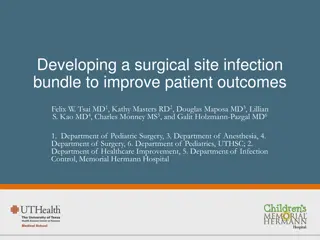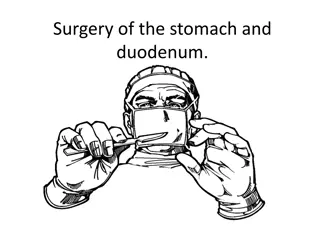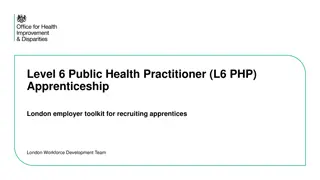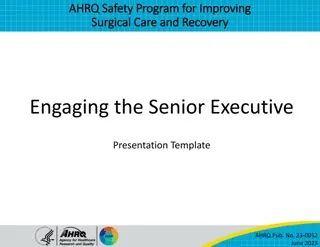Improving Public Health Support for Surgical Department Patients at Aberdeen Royal Infirmary
The Aberdeen Royal Infirmary conducted a public health pilot intervention to enhance support for patients in the Surgical Department. The project aimed to address health inequalities and promote evidence-based interventions, focusing on person-centered care and preventative medicine. By embedding practices that prioritize patient well-being and involve various stakeholders, the initiative exemplifies a collaborative approach towards improving healthcare outcomes and addressing broader societal causes of health disparities.
Download Presentation

Please find below an Image/Link to download the presentation.
The content on the website is provided AS IS for your information and personal use only. It may not be sold, licensed, or shared on other websites without obtaining consent from the author. Download presentation by click this link. If you encounter any issues during the download, it is possible that the publisher has removed the file from their server.
E N D
Presentation Transcript
Aberdeen Royal Infirmary public health pilot intervention to support Surgical Department patients Imran Arain, Libby Souter, Caroline Hartley Directorate of Public Health, NHS Grampian
Introduction Background Project design and outcomes Delivery model and patient pathways Evaluation and assessment Conclusions The way forward
Health Promoting Health Service Evidence based interventions HPH - 4 test sites HPHS/HPH - Implementation CEL (14) HPHS 2008 CEL (1) HPHS 2012 - CMO Letter 2015- Ministerial Working Group CMO letter (19) 2015-2018- Lifestyles, prevention, person centeredness, wider environment CMO letter (3) 2018 and Beyond- prevention and health inequalities, staff health, wider environment, patient pathways and quality
Contribution of NHS and prevention Embedding practice and improvement Person centred Evidence based Effective Preventative medicine Quality Strategy ambitions and delivery Person centred Safe Effective Policy, culture change, individual change Behaviour change Assets approach Broader causes Leading exemplar Inequalities in health
What we mean by health inequalities? Put simply, health inequalities are: unfair differences in the health of the population that occur across social classes or population groups not random or chance, but are caused by social inequalities out with an individual s control not inevitable, but can be addressed if there is the societal and political will to do so.
Every healthcare contact is a health improvement opportunity Equity Participation Empowerment Sustainability Grampian Clinical Strategy 2016-2021 Local Delivery Plans 2020 Vision , Realistic Medicine 2017
This project is an example of co- production Partnership between Surgical department colleagues, public health, Healthpoint, Third Sector and Acute management
Design Aberdeen Royal Infirmary Surgical Department Public Health Pilot Intervention Purpose To develop and sustain health improvement intervention within surgical department using hphs values, ethos and principles. Overall aim To improve health and reduce health inequalities by targeting identified patients.
Design Outcomes expected Improved health and wellbeing of the patients as measured through impact/process evaluation. Improved knowledge and understanding of the clinicians about HPHS values and principles, social determinants of health and health inequalities. Referral pathway, patient data and management system established to support the evaluation process. HPHS hospital based partnership working group established and collaborative way of working improved.
Methods, process and Pathways Patient recruitment (a system was established) Information and advice (Induction pack and patient leaflet) Referrals (Pathway) Specific information/advice and specialist referrals Main topics covered for advice and specialist advice (screening tool) Resources for further information and referrals (Healthpoint)
Evaluation and Assessment After 16 month of delivery Mixed-methods approach Quantitative data recorded at Healthpoint descriptive analysis ( 512 patients referred 114 agreed intervention) 22% uptake Qualitative interviews: in-depth interviews with patients, clinicians and partner agency staff NVIVO 11 based analysis (10 = 3 managers, 2 clinicians, 2 Healthpoint practitioners and 3 patients )
Results Quantitative data (During 16 moths 512 referred, 114 intervened) N (%) Gender Male Female 59 (51.8) 55 (48.2) Age (years) 18-24 25-44 45-64 65+ 5 (4.4) 32 (28.1) 47 (41.2) 28 (24.6) SIMD* Q1 Q2 Q3 Q4 Q5 7 (6.1) 24 (21.1) 22 (19.3) 29 (25.4) 30 (26.3) Smoking Status Current Smoker Non-Smoker 47 (41.2) 66 (57.9) *Scottish Index of Multiple Deprivation where Quartile 1 (Q1) indicates Most Deprived and Quartile 5 (Q5) indicates Least Deprived
Results Types and frequency of referrals to Healthpoint service Referral N (%) Smoking Cessation 31 (27.2) Healthy Eating 54 (47.4) Weight Management 47 (41.2) Physical Activity 28 (24.6) Alcohol or Substance Use 10 (8.8) Mental Health and Wellbeing 25 (21.9) Financial Advice 23 (20.2) Oral Health 7 (6.1) Sexual Health 3 (2.6) Support Groups 21 (18.4)
Qualitative results The clarity of the form (the referral form) is one of things that should be commended. And the way that it has managed to distil a lot of complex questions into quite simple language. [Manager] Facilitators of the Service we are speaking about people who are short staffed and that are maybe so focussed on actually just getting that patient through surgery, well enough to go home, how much resources do they themselves have left [Manager] Barriers to the Service ( Time management barrier ) And without [the referral form] we wouldn t have made time to do all those bits I would say. You just don t have the time as an acute nurse, you don t and its fine that somebody else can do for us. Yeah all and all it s a good service. [Clinician] Impact of the Service
Main achievements Patients awareness about wider social services Patients connection with community health and wellbeing services/activities Social inclusion and improved confidence of the patients Lifestyle support Learning around how we can develop the next phase of delivery with an improved approach
Conclusions Identified areas of success- connection with the patients on wider social determinants of health for e.g. i. lifestyles, money worries ii. person centred approach Identified areas of improvement i. Staff training around health inequalities and targeted population ii. Is the surgical department appropriate for the type of intervention? More collaborative work may be required with the external/third sector organisations for further signposting and referrals in the community settings what about link workers? Challenges due to manual data recording system.
The way forward Dealing with information technology/electronic system/data record system Selection of the priority areas (what are those?) of delivery and further interventions. Sustainability? Embedding the services
Any questions Contact for more information Imran Arain i.arain@nhs.net





